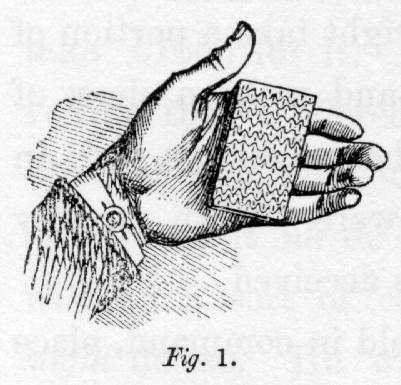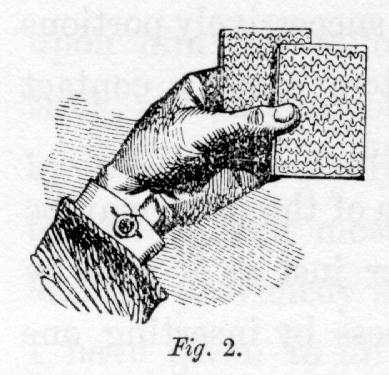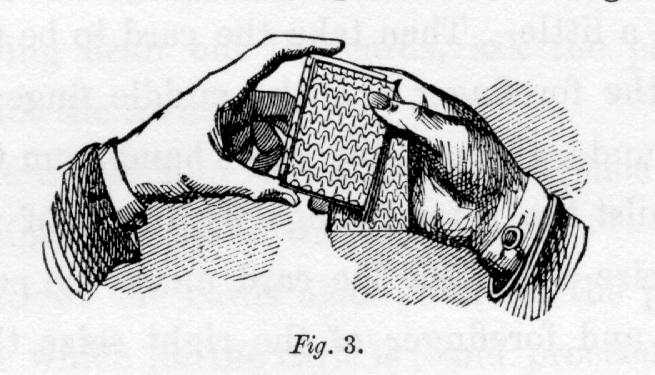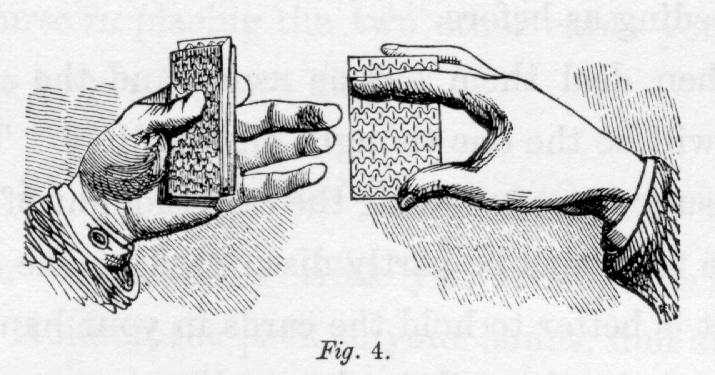| The gaming table : its votaries and victims, in all times and countries,
especially in England and in France. Vol. 2 | ||
PRELIMINARY HINTS.
I. Shuffling, in the simple and inoffensive sense of the expression, is an important point in all tricks with cards. For the most part, it is only a pretence or dexterous management — keeping a card or cards in your command whilst seeming to shuffle them into the pack.
Every performer has his method of such shuf
If a single card is to be held in command, place it at the bottom of the pack, which you hold in your left, and then, with your right thumb and middle finger, raise and throw successively portions of the pack, leaving the bottom card in contact with the fingers of the left hand.
With dexterity, any portion of the pack may be shuffled, leaving the remainder just as it was, by separating it during the process by inserting one or more fingers of the left hand between it and the portions shuffled.
II. Cutting — not in the sense of bolting at the sight of `blue,' though that is of consequence to card-sharpers — is of importance in all card tricks. In many tricks cutting the cards is only a pretence, as it is necessary for the success of the trick to replace them as they were; in technical terms, we must `blow up the cut.'[87] [87] This is the sauter la coupe referred to in the chapter on the Gaming Clubs, in the account of the trial of Lord de Ros. See `Graham's Club.'
There are several ways of performing this sleight-of-hand.
The cards being cut, and forming two lots on the table, smartly
snatch up the lot which should be placed on the other, with the
left hand, as shown in fig. 1.

Fig.1
This lot being taken up and the hand being in the position
shown in the figure, snatch up in like manner the other lot, and,
by a movement of the palm of the hand and the tips of the
fingers, pass the second lot under the first, as shown in fig.
2.

Fig. 2
The deception of the trick depends upon its dexterity, and this can only be acquired by practice. But really it may be dispensed with; for it is a curious fact that, in every case when the cards are cut, you may actually replace them just as they were without being observed by the spectators — for the simple reason that the ruse is not suspected,
The `gift of the gab' is in this case, as in many others, a very great resource. A striking remark or bon mot will easily mystify the spectators, and attract their attention from what you are doing. Hence all prestidigitators are always well stocked with anecdotes and funny observations; indeed, they talk incessantly: they speak well, too, and they take care to time the word accurately with the moment when their fingers act most energetically.
III. To slip a card. — To slip a card is to pretend to take the bottom card of the pack, and in reality to take the card which precedes it. To perform this feat without detection is a very simple affair, but it requires practice.
The pack of cards being held in the right hand,

Fig. 3
In this manner you may successively draw out several cards besides the last, and only draw the last as the sixth, seventh, &., which will serve to effect several interesting tricks to be explained in the sequel.
IV. To file the card.— To file the card is, when a card has been taken from the pack to pretend to place it about the middle of the pack, whilst, in reality, you place it at the bottom.
The pack must be held in the left hand, between the thumb and forefinger, so that the three other fingers be free. One of the middle cards should project a little. Then take the card to be filed between the forefinger and the middle finger of the right hand; advance the right hand from the left, and whilst the three disengaged fingers of the left hand seize and place the card under the pack, the thumb and forefinger of the right seize the projecting card before mentioned, so that it seems to be that card which you have slipped into the

Fig. 4.
| The gaming table : its votaries and victims, in all times and countries,
especially in England and in France. Vol. 2 | ||